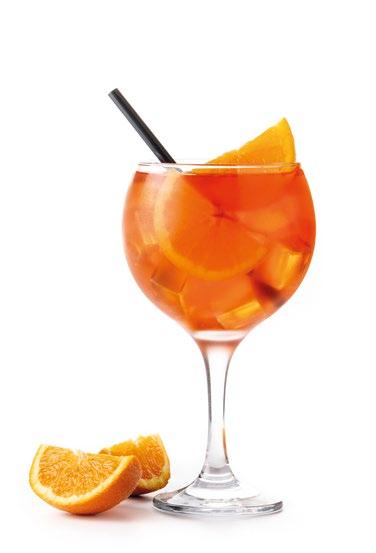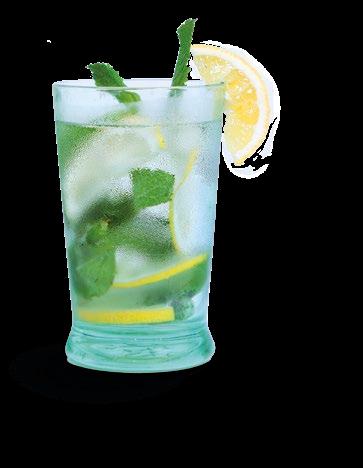
3 minute read
SHAKING THINGS U P
TEXT BY FERNANDA ROGGERO
Alessandro Di Gregorio has had a dazzling career. He opened his first bar at the age of 23, in Sicily. He went on to serve as a brand ambassador for Campari, and to manage the bars of the Pourcel Group of triple-starred chefs Jacques and Laurent Pourcel in Montpellier, where he now lives, overseeing their operations in France, Vietnam and Sri Lanka.

But he still remembers how he got started, in a downtown bar in Caltagirone, standing on a plastic box behind the counter at the age of 12.
“I couldn’t reach the coffee machine!” he laughs. “But that world fascinated me – I felt important, and liked to think how fundamental those five minutes they spent in our company were for our customers.”
Working for the Pourcels, he says, he discovered "the important interconnection between cocktails and haute cuisine," which has revolutionized the bartender's work over the past two decades. The great classics have given way to increasingly complex signature cocktails, and increasingly innovative techniques. "It's all very interesting," says Alessandro, "except that the hospitality side has been lost a bit. We are all so focused on the show and the complexity of the cocktails to be served, that we are forgetting our main goal, which is to make our customers have a good time.”
So he never forgets to engage with them, even with the most basic inquiries: alcoholic or non-alcoholic? Dry or sweet? The rest, he says, follows on naturally from that first contact.
Just as in kitchens, these days behind bar counters professionals talk of extractions, infusions and fermentations. "These are very old techniques that are making a comeback, in both haute cuisine and mixology - which increasingly draws inspiration from fine dining,” explains Allessandro. “They certainly allow us to experiment and offer new taste palettes to our guests."

And to offer new products. Considering the new trend of alternative pairing, Di Gregorio has thought about creating mixed, infused and / or fermented drinks that are ready bottled, very low in alcohol content or even nonalcoholic. "It is very difficult to create virgin cocktail pairings that are not too sweet and overpowering in terms of taste,” he says, “so I am dusting off ancient procedures in order to create perfectly balanced drinks that can be enjoyed as an accompaniment to a wide variety of dishes.” At first these new creations will be available only in his new venue, which opens in Montpellier next March. He will also offer gourmet versions of Italianstyle aperitifs.
If bartenders have changed, it is because customers have too, and are now much more knowledgeable and curious. "They are familiar with the great classics but at the same time they are more willing to try new tastes and new experiences," agrees Alessandro. "The demands vary from person to person, but I would say that for a variety of reasons – health, ethical, religious –low-alcohol cocktails are now a growing trend everywhere in the world. People are more health-conscious and, above all, they realise that it is possible to drink well without alcohol. People who want a non-alcoholic drink are no longer obliged to ask for a simple soda or a juice."
Take aperitifs. The idea is to stimulate the taste buds in anticipation of the meal. Bitterness provokes the greatest reaction on the tongue, as in a Spritz, Negroni, or Americano, but how is this achieved without alcohol? "A nonalcoholic aperitif that I really like is the carbonated infusion of gentian root mixed with blood orange nectar,” says Alessandro. “Simple and effective. You can make it at home or on the boat by putting the gentian root in boiling water, letting it sit for 24 hours and then adding carbon dioxide with a siphon or soda stream. Just serve with a good sweet blood orange juice and lots of ice." The ingredients that can be the most useful are those that tone down the sweetness of seasonal fruits, such as tea, ginger, lemongrass, mint and spices.
And on board, what are the professional's suggestions?
"On the boat, I suggest keeping it simple. During the day, non-alcoholic drinks with fresh fruit extracts, soda
(or champagne, if you want low-alcohol) and lots of ice. An example? Pineapple juice, ginger extract, ice and top with soda or champagne. In the evening, I would suggest having a cocktail of vodka, fresh crushed fruit (choosing local and seasonal ones at each port you stop at), soda and lots of crushed ice, or just a good glass of champagne or white wine.”
Alex joined the Heesen press cruise on board the 60-metre full-custom MY Lusine. For the twelve lucky guests on this exclusive voyage from Monaco to Ramatuelle, near St Tropez, he prepared three refreshing ‘mocktails’: fresh squeezed lemonade with wild fennel soda and lemongrass syrup, coconut water with pineapple juice and cinnamon reduction, and pink grapefruit juice with lime and honey and jasmine infusion tea.
Alex says he loves exploring gastronomic cultures when he travels, and he gets inspired by local products. In the Côte d'Azur, for example, a chilled Côte de Provence rosé, served with some fresh raspberries, is hard to beat.
And what does he drink at home with his wife Lorena?
"I love to drink a good whisky. It is by far my favourite spirit. For mixing, though, I prefer pisco and mezcal."



